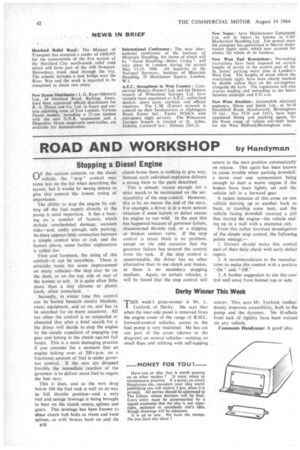ROAD AND WORKSHOP by Handyman
Page 44

If you've noticed an error in this article please click here to report it so we can fix it.
Stopping a Diesel Engine
OF the various controls on the diesel vehicle, the " stop " control may come last on the list when describing the layout. but it would be wrong indeed to give this control the lowest rating of importance.
The ability• to stop the engine by cutting off the fuel supply directly at the pump is most important. It has a bearing on a number of factors, which include unscheduled damage, accident risks—and, oddly enough, safe parking. As there appears little connection between a simple control wire or rod, and the factors above, some further explanation is called for.
First and foremost, the siting of this control—it can be anywhere. There is certainly room for some improvement on many vehicles—the stop may be on the dash, or on the top, side or rear of the bonnet or cab. It is quite often little more than a tiny chrome or plastic knob, often unmarked. • Secondly, in winter Cute this control can be buried beneath sundry blankets, coats, equipment, and so on, and has to be searched for on many occasions. All too often the control is so concealed or obscured that after a brief search for it the driver will decide to stop the engine by the simple expedient of engaging top gear and letting in the clutch against full brake. This is a most damaging practice if you consider for a moment that an engine ticking over at 200 r.p.m. on a fractional amount of fuel is under governor control. If the revs are dropped forcibly the immediate reaction of the governor is to deliver more fuel to regain. the lost revs.
This it does, and as the revs drop below 100 the fuel rack is well on its way to full throttle position—and a very real and savage leverage is being brought to bear on the clutch centre, splines and gears. This leverage has been known to shear clutch hub bolts or rivets and twist splines, as with brakes hard on and ihe clutch home there is nothing to give way. Instead, each individual explosion delivers a strong blow to the parts described.
This is already reason enough for a strict watch to be maintained on the serviceability of the stop control. However, th:s is by no means the end of the story: For example, a driver is in a most serious situation if some failure or defect causes his engine to run wild. In the past this has happened because of governor failure, disconnected throttle rod, or a slipping or broken venturi valve. If the stop control is intact there is no problem, except on the odd occasion that the governor failure has severed the control from the rack. If , the stop control is unserviceable, the driver has no other alternative than to use clutch and brakes, as there is no secondary stopping medium. Again, on certain vehicles, it will be found that the stop control will
return to the start position automatically on release. This again has been known to cause trouble when parking downhill, a move over one compression being enough to start a warm engine if the brakes have been lightly set and the vehicle left in a forward 'gear.
A recent instance, of this arose on one vehicle moving up to another . back to back, to tranship some item, and the vehicle facing downhill received, a jolt that started the engine—the vehicle ending LID in a wall with a shattered cab.
From this rather involved investigation of the simple stop control, the following points emerge:— I. Drivers should make this control part of their daily check with early defect report.
2. A recommendation to the manufacturer to make this control with a positive " On " and "Off."
3. A further suggestion to site this control well away from bonnet top or side.




















































































































